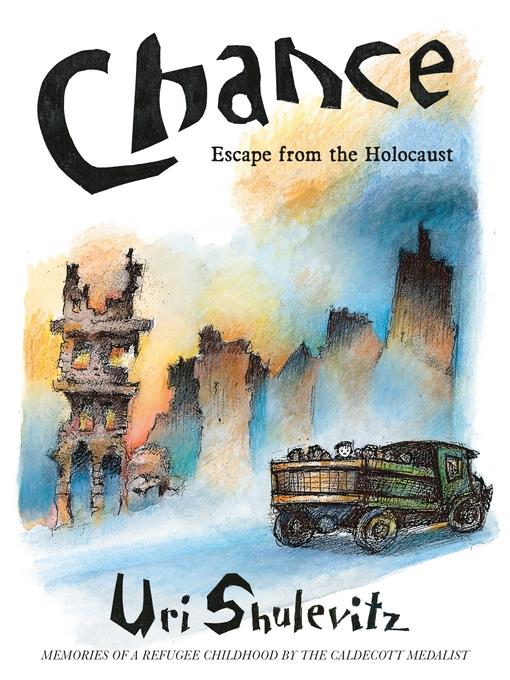
Chance
Escape from the Holocaust: Memories of a Refugee Childhood
کتاب های مرتبط
- اطلاعات
- نقد و بررسی
- دیدگاه کاربران
نقد و بررسی

Starred review from July 13, 2020
This searing, evocative memoir chronicles the wartime experiences of Caldecott Medalist Shulevitz, whose family fled 1939 Warsaw to avoid persecution when he was four years old, only to suffer starvation and other tribulations in the Soviet Union, Poland, and Germany before eventually settling in Paris. The spare, keenly observed narrative offers a harrowing look at a Jewish family’s plight during WWII while documenting the birth of an artist with a great capacity for creativity: Shulevitz draws stick figures in profile before the war, sketches “with my finger in the air” to distract himself from hunger in Turkestan, and hones his craft to win a citywide drawing competition in Paris. Stark and powerful black-and-white drawings by the author underscore gritty realities: people forced to carry water after Nazi planes bomb Warsaw, tension and fear in a truck bound for Białystok, confrontations with Soviet officials, and a crowded bed the family inhabits in a settlement work camp. This affecting memoir of Shulevitz’s childhood as a war refugee provides a deeply personal testament to the power of art. Ages 8–14. (Oct.)■

July 15, 2020
The award-winning author and illustrator recounts his harrowing childhood as a Polish Jew during World War II. When the Germans invade Poland in 1939, 4-year-old Uri and his parents flee from Warsaw to Soviet-occupied Bialystok, where they are considered enemies of Soviet Russia and denied citizenship. First sent to the Archangel region, after the Germans invade Russia they travel to Turkestan in the Central Asian Kazakh Republic, where, as a 7-year-old, Uri wonders at a way of life that is completely unfamiliar. Shulevitz shares experiences of hunger, deprivation, and anti-Semitism while living in makeshift abodes and tiny apartments and enduring endless train rides. What sustains him are his mother's storytelling, which instills in him an enduring passion for stories, and drawing to pass the endless hours. Drawing allows him to escape into his imagination and ward off loneliness. The first-person narrative, which continues through his teen years in Paris, is inviting and filled with absorbing details of everyday life, from playing games to facing bullies and fearsome dogs. The many illustrations--scary, imaginative, and humorous--are a brilliant accompaniment to the text, bringing into sharp focus stark images of civilians caught up in war. Despite the horrors, however, there is a strong sense of intimacy between the author and his readers. Fans of his many books will appreciate the references to One Monday Morning (1967) and How I Learned Geography (2008). A memorable journey of survival and artistry. (photographs) (Memoir. 10-14)
COPYRIGHT(2020) Kirkus Reviews, ALL RIGHTS RESERVED.

Starred review from August 1, 2020
Grades 3-6 *Starred Review* Distinguished Caldecott Medal-winning author-illustrator Shulevitz creates an arresting and affecting memoir of terrible privation that focuses on his life from 1939, when he was 4, to 1949, when he turned 14. His story begins in Warsaw with a German air raid, of which he writes, The distance between life and death had vanished. To put distance between themselves and war, his Jewish family?his mother, father, and himself?flee to the small town of Bialystock in Belarus. Their life there becomes increasingly difficult, for they have no Russian passports, and they are ultimately transported to Settlement Yura in the Russian Republic of the Soviet Union. In 1942, they begin another journey, this time to the small town of Turkestan in the Kazakh Republic, where his family lives for three long years in a state of near starvation. There is much more to his story, but two things remain his salvation: his lifelong love of stories and his passion for drawing, both of which have stood him in such good stead in his subsequent creative life. The book's spare, straightforward text is liberally illustrated with Shulevitz's black-and-white Expressionist-style drawings plus the occasional photograph that has survived the war. Together, the images brilliantly capture the often-somber story of Shulevitz's early life, which he ultimately survived, as he says, by chance.(Reprinted with permission of Booklist, copyright 2020, American Library Association.)

Starred review from November 1, 2020
Gr 5-8-Shulevitz, a Caldecott Medalist and celebrated author of children's literature, offers a profoundly honest memoir that chronicles his childhood during the time of the Holocaust. The work details eight difficult years of survival; Shulevitz and his parents lived as refugees, fleeing Warsaw to many parts of the war-torn European landscape, including the Soviet Union, the city of Turkestan, and France. Shulevitz's relationship with art, as a means of genuine expression and as a constant companion, is apparent not only in the memories he shares but also in his drawings. His illustrations showcase a great deal of emotional resonance. The drawings are a testament to his mastery of line manipulation; he deftly captures movement and facial expressions. His contemplative narrative voice observes his younger self and his parents, recalling personal uncertainties, regrets, and hopes. His recollections unfold in scenes or moments. The chapter lengths vary from treasured insights to full retellings of his father's stories, unfolding in response to the pace of constant, sometimes jarring, changes he experienced. It is a privilege to hear this renowned artist reflect on his past, where hunger, loneliness, and fear battled with resilience, family strength, and the power of imagination. VERDICT Middle school readers will find Shulevitz's darkly captivating memoir hauntingly impressive and extraordinary. He admirably recollects how art became his guiding light in the darkness.-Rachel Mulligan, Pennsylvania State Univ.
Copyright 2020 School Library Journal, LLC Used with permission.

























دیدگاه کاربران